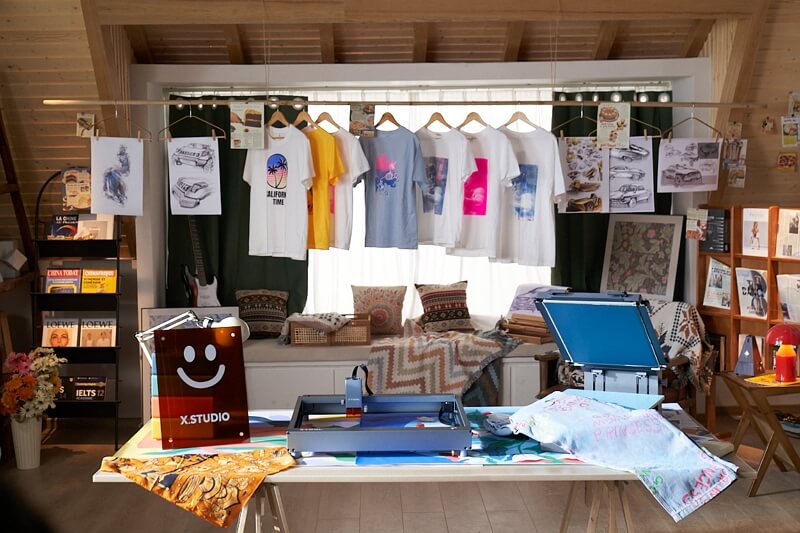Tx Tees Fundamentals Explained
Tx Tees Fundamentals Explained
Blog Article
A Biased View of Tx Tees
Table of ContentsOur Tx Tees IdeasThe Definitive Guide to Tx TeesExcitement About Tx TeesMore About Tx TeesThe Tx Tees IdeasGetting The Tx Tees To WorkOur Tx Tees Diaries
Add up various other expenses, like the number of utilities it takes to run the store and the cost of ink and solution per style. Take the print listed below.The emulsion must only be a few cents considering that you 'd just need to coat one screen for this task. So just how much should you charge per tee shirt to make an earnings? Generally, printers try to make up to 45% profit on a print task. Below's a table to aid you identify that: overall price per thing percent of wanted earnings as a decimal (instance:.25 or.45) profit made per item per work Currently allowed's talk concerning the success of DTF.

With DTF, you can print a handful of shirts, or just one. Both display printing and DTF have their specific niches in the globe.
The Tx Tees Diaries
The best means to understand? Ask about and see what printing shop like yours are doing. screen printing shop. Try both out and see which you like far better
When you're choosing what kind of printing technique to utilize for publishing your artwork designs on your garments, it is essential that you recognize the distinctions between these two methods so you can maximize results while lessening prices. Display printing is one of the most generally used method for printing styles on textiles.
DTG printing is likewise recognized as place or straight to garment printing due to the fact that it publishes only what is needed as opposed to making a display as display printers do. https://moz.com/community/q/user/txtees02. Screen printing functions by screen filler squeegee display printing ink display mesh screen, after that transferring the picture to garment utilizing warmth and/or pressure
The DTG printer uses unique dye-sublimation inks that are applied right into a pre-designed image by an electronic printing system. The inks enter into the material, enabling dynamic shades and outstanding detail. It's likewise called area or straight to garment printing because it publishes only what is required rather than making a screen as display printers do.
The 2-Minute Rule for Tx Tees
First, it's much quicker - you can publish a fullcolor image in mins, instead of hours for screen printing. Second, there's no established up time or expenses entailed - you can publish any design you like, without having to create a screen. Third, there's no waste - since screen printers screen print one design at a time, they have to screen each color separately.
The paper is very costly and can just be utilized when. Once it's printed on, it needs to be thrown out. - The first acquisition cost is lower than the ahead of time financial investment of DTG printers- You can publish multi-color styles one screen at a time rather than having to publish each shade independently like DTG printing.

How Tx Tees can Save You Time, Stress, and Money.
However, instead of utilizing screen mesh as display printers do, dye sublimation printers utilize laser modern technology to transfer your photos onto garments or paper. A warmth procedure transfers the color from its solid-state straight right into the gas stage which subsequently fuses it onto material substratums when they are swiftly warmed to high temperature levels under high stress.
Sublimation printing is green. It uses less water than screenprinting, and because it doesn't include the usage of unsafe solvents, it's safe for all types of garments. The dye sublimation inks are also odor-free when healed, unlike display printers that utilize harmful chemicals during the display printing process that leave behind an unpleasant odor.
They likewise save money on pricey equipment like exposure units given that dye sublimation printers don't require a UV exposure system or a flash treatment stove that is typically used in screen printing (t-shirt printing). What is direct to garment printing (DTG Printing)? DTG printing is a digital screenprinting procedure that publishes straight onto material making use of specialized inkjet printers
Not known Incorrect Statements About Tx Tees
DTG printing provides many advantages over standard screenprinting, consisting of the ability to publish photographic quality images, better shade vibrancy, and the ability to publish designs on darker textiles. DTG printers function by heating the fabric ink until it develops into a gas. The gas then penetrates the fabric, bonding with the fibers to develop a permanent print.

Display printers just prepare their screen after that start printing until they run out of item or ink.- There is a variety of knowledgeable screen printers all over the world, which can be helpful for beginners. - It's a slower process - display printers often need to await the ink to dry prior to they can print the following shade- Display printers call for hand-operated labor, so there's a greater understanding contour and it takes longer to produce a top notch style- Screen printing isn't as accurate as DTG printing, so you might get some "bleeding" of shades from one component of the picture onto an additional if not done appropriately.
The Single Strategy To Use For Tx Tees
Nonetheless, instead of using screen mesh as display printers do, dye sublimation printers make use of laser innovation to move your pictures onto garments or paper. A warmth process moves the color from its solid-state directly into the gas stage which subsequently merges it onto textile substrates when they are quickly warmed to high temperatures under high stress.
Sublimation printing is green. It utilizes much less water than screenprinting, and because it doesn't involve using harmful solvents, it's safe for all kinds of clothing. The dye sublimation inks are also odor-free when healed, unlike screen printers that use dangerous chemicals throughout the display printing procedure that leave behind an unpleasant odor.
They likewise save money on pricey tools like direct exposure units given that dye sublimation printers don't need a UV direct exposure device or a flash treatment stove that is generally utilized in screen printing. What is direct to garment printing (DTG Printing)? DTG printing is an electronic screenprinting procedure that prints directly onto fabric using specialized inkjet printers.
Tx Tees for Beginners
DTG printing uses lots of benefits over standard screenprinting, consisting of the capability to print photographic top quality photos, greater color vibrancy, and the capacity to publish styles on darker fabrics. DTG printers function by heating the textile ink till it becomes a gas. The gas then permeates the fabric, bonding with the fibers to create a permanent print.
Report this page